You already know that Australia is a continent located in the Eastern and Southern hemispheres of our planet Earth. The mainland itself is part of the world of Oceania and Australia.
Geographic location of Australia
The continent called Australia covers an area of 7,659,861 km² in the Southern Hemisphere. The coastline has a length of 35 thousand km, the width of the continent is 4000 km, and the length reaches 3700 km.
Close to Australia are islands such as Tasmania and New Guinea. The western and southern coasts of Australia are washed by the waters indian ocean, and the eastern and northern coasts - by the seas Pacific Ocean.
These are the Timor, Coral, Arafura and Tasman seas. Also near northeast coast Australia has the largest coral reef in the world, the Great barrier reef stretches for more than 2000 km. Its width can reach 150 km.
The westernmost point of the mainland is Cape Steep Point, the eastern one is Cape Byron, the northernmost point is Cape York, and the southernmost point of Australia is South Point.
To a large extent, Australia is located in a hot thermal zone, and the shores of the mainland are slightly indented. In the south of Australia is the Great Australian Bight, and the Gulf of Carpentaria is in the north, as are the two peninsulas of Cape York and Arnhem Land. Inland seas Australia is connected with Southeast Asia.
History of mainland exploration
The smallest of all, this mainland had to be searched for quite a long time. In 1606, the strait was opened, which separates New Guinea from the mainland. This strait was named after the discoverer - Torres. And in the same year, the navigator Janszon ended up on the coast of the Gulf of Carpentaria.
A few decades later, in 1643, it was proved that Australia is a single land. The navigator Tasman proved this and he also discovered the island, which was later named after him.
In 1770, James Cook, being a famous English navigator, found himself on east coast Australia itself. Since then, the process of colonization by the British began, the study of Australia as a separate continent, and the economic development of its territory.
The lands of Australia became known as New South Wales. In those days, Australia became a place of exile for criminals convicted of minor infractions. Later, the settlement, considered a British colony, was named Sydney. It was founded on January 26, 1788 by Captain Arthur Philip.
And the territory of Tasmania joined the rest of the lands of Australia in 1829. The middle of the 19th century is the beginning of the "gold rush" in Australia, it is for this period that waves of mass immigration to Australia are characteristic.
And in 1901 - January 1 - Australia became independent state to form the Commonwealth of Australia.
Need help with your studies?
Previous topic: South African countries: South Africa and MozambiqueNext topic: Features of Australia's nature: flora and fauna of Australia
Lyceum of Information Technologies Essay on geography on the topic: Plan: 1. Political and economic geographical position Australia. 2. The population of the country. 3. Natural resources and conditions. 4. Industry. 5. Agriculture. 6. Development of service industries. 7. Foreign economic relations. References: 1. Lutsian Volyanovsky “The Continent that has ceased to be a legend”, 1991. 2. http://gemini.sch265.spb.su/rsant/australia/ 3. http://153.233.17.121/travel/docs/country/australia/ 4. http://www.maindir.gov.ru/ GUIR/countries/ 5. http://groucho.mit.csu.edu.au/ 6. http://rolf.ece.curtin.edu.au/~clive/agrirobot/ 7. http://www.csu .edu.au/australia/gallery Commonwealth of Australia. Political and economic-geographical position. Australia is the only country in the world that occupies the territory of an entire continent, so Australia has only maritime boundaries. Australia's neighboring countries are New Zealand, Indonesia, Papua New Guinea and other island states of Oceania. Australia removed from developed countries America and Europe, large markets for raw materials and sales of products, but many sea routes connect Australia with them, and Australia also plays an important role in the Asia-Pacific region. Australia has a federal structure and includes 6 states: New South Wales, Victoria, Queensland, South Australia, Tasmania, Western Australia - and 2 territories: Northern Territory, Australian Capital Territory. The territory of the country is 7682 thousand square kilometers, located on the Australian mainland, Tasmania and other islands. The capital of Australia is Canberra. Australia is a federal state within the Commonwealth led by Great Britain. The head of state is the Queen of England, represented by the Governor General, who is appointed on the advice of the Australian government. The highest legislative body is the Federal Parliament, consisting of the Senate, elected for 6 years (76 members, renewed by half every 3 years) and the House of Representatives (148 members), elected for 3 years. General elections were held in March 1993. The executive power formally belongs to the executive council headed by the governor general, in fact it is exercised by the government headed by the prime minister. Each state has its own constitution, government and administration. A special management system has been established in the territories. Governor General - William Hayden; Prime Minister - Paul Keating. The leading party in Australia is the Australian Labor Party (APL), formed in 1891. The basis of the party is trade unions that are part of it as collective members, youth and women's organizations, there is also an individual membership. The policy of the party is largely determined by the parliamentary faction, the parliamentary leader in the event of a party victory in the elections automatically becomes the prime minister. Party leader - Paul Keating. The Liberal Party of Australia, founded in 1944, expresses the interests of the big bourgeoisie, the National (Agrarian) Party of Australia, founded in 1916, expresses the interests of large landowners and pastoralists, forms a coalition with the Australian Labor Party, there are many more parties in Australia (Party of Australian Democrats, Nuclear Disarmament Party, Rural Australia Party, etc.). Population. In 1996 The population of Australia was 18,284,373 people, so Australia's place in terms of population in the world is in the fortieth. 77% of the population of Australia are descendants of immigrants from the British Isles - the British, Irish, Scots, who formed the Anglo-Australian nation, the rest are mostly immigrants from other countries. European countries, natives and mestizos - 250 thousand people. (1991). Most of the country's population are immigrants. Every fourth inhabitant of Australia was born outside of it. After the Second World War, an immigration program began to be implemented, during which the population of the country was increased from 7.6 million people in 1947. up to 15.5 million people in 1984 About 60% of this growth came from immigrants and their children born in Australia. The population of Australia.
| Index | 1976 | 1981 | 1986 | 1990 | 1991 | 1992 | 1993 |
| Population, million people | 14,03 | 14,92 | 16,01 | 17,07 | 17,28 | 17,48 | 17,66 |
| Share of urban population, in % | 86,0 | 85,7 | 85,4 | 85,5 | 85,2 | ||
| share rural population, V % | 14,0 | 14,2 | 14,6 | 14,5 | 14,8 | ||
| Men, in % | 50,2 | 49,9 | 49,8 | 49,9 | 49,8 | 49,8 | 49,8 |
| Women, in % | 49,8 | 50,1 | 50,2 | 50,1 | 50,2 | 50,2 | 50,2 |
| Number of births, per thousand population | 16,4 | 15,8 | 15,2 | 15,4 | 14,9 | 15,1 | 14,7 |
| Number of deaths, per thousand population | 8,3 | 7,3 | 7,2 | 7 | 6,9 | 7,1 | 6,9 |
| natural increase | 8,1 | 8,5 | 8 | 8,4 | 8 | 8 | 7,8 |
| Lifespan: | 71,478,4 | 72,979,2 | 73,379,9 | 74,480,3 | 73,780 |
| Index | 1970 | 1975 | 1980 | 1985 | 1990 | 1991 | 1992 | 1993 | 1994 |
Extraction of iron ore, million tons: By weight of ore | 112,1 | 116 | 123,9 | ||||||
| Pig iron smelting, million tons | 6,1 | 7,7 | 7 | 5,6 | 6,1 | 5,6 | 6,4 | 6,4 | 7,2 |
| Steel smelting, million tons | 6,7 | 8 | 7,6 | 6,6 | 6,6 | 6,2 | 6,5 | 6,8 | 7,6 |
| Index | 1970 | 1975 | 1980 | 1985 | 1990 | 1991 | 1992 | 1993 | 1994 |
| Copper mining, thousand tons | 157,8 | 219 | 235 | 252 | 327 | 326 | 340 | 394 | 381 |
| Production of refined copper from ores and secondary raw materials, thousand tons | 145,5 | 192 | 182,4 | 194,3 | 274 | 279 | 304 | 312 | 331 |
| Consumption of refined copper, thousand tons | 106 | 97 | 126,2 | 123,7 | 120 | 101,2 | |||
| Zinc mining, thousand tons | 487 | 51 | 518 | 744,4 | 863,4 | 1001 | 1022 | 1000 | 985,1 |
| Production of zinc ingots, thousand tons | 263,9 | 193 | 304,6 | 292 | 294,7 | 320,4 | 325 | 332 | 315 |
| Lead mining, thousand tons | 458 | 408 | 397,5 | 498 | 526,4 | 562 | 569 | 557 | 519 |
| Production of refined lead from primary and secondary raw materials, thousand tons | 213 | 193,5 | 232,6 | 226,1 | 197 | 197 | 232 | 239 | 211 |
| Tin mining, thousand tons | 8,9 | 9,6 | 11,6 | 6,4 | 8,3 | 5,7 | 6,2 | 7 | 8 |
| Production of primary tin, thousand tons | 5,2 | 5,3 | 4,8 | 2,7 | 0,4 | 0,3 | 0,2 | 0,3 | 0,2 |
| Aluminum mining, thousand tons | 224,6 | 263,8 | 341,5 | 926,4 | 1235 | 1236 | 1243 | 1300 | 1382 |
| Production of primary aluminum, thousand tons | 205,6 | 214 | 303,5 | 851,7 | 1233 | 1235 | 1243 | 1300 | 1382 |
| Index | 1970 | 1975 | 1980 | 1985 | 1990 | 1991 | 1992 | 1993 | 1994 |
| Production of secondary aluminum, thousand tons | 19 | 25 | 38 | 45 | |||||
| Aluminum consumption, thousand tons | 124 | 133 | 228,5 | 288,4 | 287,8 | 304,6 | |||
| Nickel production, thousand tons | 29,8 | 75,8 | 74,3 | 85,8 | 67 | 69 | |||
| Cobalt production, thousand tons | 0,31 | 1,05 | 3,13 | 2,6 | |||||
| Mining of manganese, thousand tons | 672,9 | 2019 | 2003 | 1988 | 1482 | ||||
| Bauxites, thousand tons | 9256 | 21034 | 27629 | 31864 | 39914 | 41753 | 39856 | 41180 | 41733 |
| Gold mining, t | 20,5 | 15,2 | 18,3 | 48,9 | 222,6 |
| Index | 1970 | 1975 | 1980 | 1985 | 1989 | 1990 | 1991 | 1992 | 1993 |
| Oil, million tons | 8,5 | 18,4 | 18,9 | 24,6 | 24,6 | 27,5 | 27,3 | 26,9 | |
| Gas, bcm | 1,5 | 4,6 | 9,6 | 13,1 | 16,2 | 20,5 | 21,7 | 23,2 | |
| Coal, million tons | 45,2 | 60,7 | 72,5 | 117,5 | 147,8 | 158,8 | 164,6 | 175,1 | 176,5 |
| Brown coal, million tons | 24,2 | 17,9 | 32,9 | 38,4 | 48,3 | 46 | 49,4 | 50,7 | 47,7 |
| Installed capacity of power plants at the end of the year, million kW. | 15,6 | 21,1 | 25,7 | 32,9 | |||||
| Electricity generation, billion kW/h | 53,9 | 73,9 | 96,1 | 148 | 155 | 157 | 159 | 162 | |
| Hydroelectricity, billion kWh | 9,2 | 15,2 | 13,8 | 14,3 | 14,5 |
| Index | 1970 | 1975 | 1980 | 1985 | 1990 | 1991 | 1992 | 1993 | 1994 |
| Sulfur production, thousand tons | 433 | 255 | 180 | 202 | 210 | 210 | 210 | ||
Production of basic inorganic acids, thousand tons: Nitrogen Salt | 1904 | 1464 | |||||||
| Production of caustic soda, thousand tons | 112,4 | 139,2 | 135 | ||||||
| Chlorine production, thousand tons | 92 | 113 | 110 | ||||||
Production of mineral fertilizers, thousand tons: Nitrogen · Phosphoric | |||||||||
| Gasoline production, million tons | 7,4 | 9,3 | 10,9 | 11,5 | 12,1 | 11,5 | 12,6 | 13 | 13,1 |
| Production of motor and diesel fuel, million tons | 4,3 | 5,8 | 7,3 | 7,1 | 8,7 | 8,7 | 9 | 9,7 | 9,8 |
| Production of fuel oil (furnace and naval), mln.t | 7,1 | 4,7 | 3,8 | 2,9 | 2,2 | 2,4 | 2,6 | 2,4 | 2,3 |
| Production of lubricating oils, million tons | 0,4 | 0,4 | 0,6 | ||||||
| Production of kerosene and jet fuel, million tons | 2,3 | 2,3 | 2,9 | 2,9 | 3,3 | 3,6 | 3,6 | ||
| Production of synthetic resins and plastics, thousand tons | 225,6 | 362,4 | 709,2 | 850 | 986 | 977 | 970 | ||
| Manufacture of chemical fibers and threads, thousand tons | 35,2 | 38,7 | 32 | 38,6 | 46,2 | 48 | 50 | ||
| Index | 1970 | 1975 | 1980 | 1985 | 1990 | 1991 | 1992 | 1993 | 1994 |
| Production of synthetic rubber, thousand tons | 33 | 37,6 | 46 | 31,2 | 40,8 | 35,5 | 40 | 46,4 | 44,6 |
| Index | 1970 | 1975 | 1980 | 1985 | 1990 | 1991 | 1992 |
| Export of wood, million cubic meters | 13,8 | 14,6 | 17,1 | 19,7 | 20,3 | 21 | 21,3 |
| Production of lumber, million cubic meters | 3,2 | 3,3 | 3,2 | 3 | 3,2 | 3,2 | 3,3 |
| Production of fibreboard, million sq.m. | 44,9 | 37 | 26,5 | 26 | 30,9 | 31,8 | 31,6 |
| Particle board production, thousand cubic meters | 264 | 379 | 622 | 675 | 743 | 765 | 780 |
| Paper production, thousand tons | 656 | 759 | 959 | 1091 | 1456 | 1480 | 1580 |
| Cement production, million tons | 4,5 | 5,1 | 5,2 | 5,7 | 7,1 | 6,1 | 5,9 |
| Lime production, million tons | 434 | 563 | 1179 | 1100 | |||
| Asbestos production, thousand tons | 0,8 | 37 | 84 |
| Index | 1970 | 1975 | 1980 | 1985 | 1990 | 1991 | 1992 |
| Production of cotton yarn, thousand tons | 28,3 | 22,8 | 21,8 | 19,9 | 22 | 24 | 25 |
| Index | 1970 | 1975 | 1980 | 1985 | 1990 | 1991 | 1992 |
| Production of wool yarn, thousand tons | 26,5 | 18,5 | 17,9 | 22,4 | 9,2 | 19 | 18,1 |
| Total fabric production, mln. sq.m | 139 | 155,8 | 168 | 178,5 | 7,2 | ||
Production Cotton fabrics, million sq.m | 53,7 | 49,1 | 30 | 37 | 38 | 36 | 40 |
| Production of woolen fabrics, million sq.m | 27 | 14 | 12 | 9,6 | 7,8 | 7,7 | 8,8 |
| Production of silk fabrics, million sq.m | 58,3 | 92,7 | 126 | 142 | |||
| Production of carpets and rugs, million sq.m | 15,3 | 24,2 | 30,6 | 41,5 |
| Index | 1970 | 1975 | 1980 | 1985 | 1990 |
| Production of granulated sugar, thousand tons | 2313 | 2626 | 3064 | 3109 | 3253 |
| Margarine production, thousand tons | 63,5 | 82,4 | 139,9 | 146,3 | |
| Catch of fish and seafood (including the harvest of sea animals, whales, crustaceans and mollusks), thousand tons | 101,4 | 108,7 | 132 | 161 | |
| Grape wine production, thousand hectoliters | 2868 | 3612 | 4100 | 4512 | |
| Beer production, thousand hectoliters | 15533 | 19545 | 20232 | 18553 | 19500 |
| Production of soft drinks, thousand hectoliters | 6521 | 9321 | 9389 | 13729 | |
| Extraction of edible salt, million tons | 2,1 | 5,1 | 5,3 | 6,2 |
| Index | 1970 | 1975 | 1980 | 1985 | 1990 | 1991 | 1992 |
| Launching of sea merchant ships (capacity of 100 gross registered tons and above), thousand gross registered tons | 54 | 33 | 8 | 11 | 25 | 25 | 11 |
| Production of cars and buses, thousand units | 478,4 | 456,2 | 456,5 | 405,9 | 285 | ||
| Production of passenger cars, thousand units | 374 | 361 | 399,3 | 376 | 361 | 278 | 268 |
| Production of trucks, thousand units | 85,7 | 92,8 | 55,8 | 28,9 | 14 | ||
| Bus production, thousand units | 2,3 | 2,3 | 1,4 | 1 | 1 | ||
| Production of grain harvesters, thousand units | 1,5 | 2,2 | 1,3 | 1 | |||
| Production of broadcast televisions, thousand units | 320 | 457 | 332 | 299 | 158 | 170 |
| Index | 1970 | 1975 | 1980 | 1985 | 1990 |
Length transport routes, thousand km: · Railways · Car roads | |||||
Density of the network of transport routes (km. of transport routes per 1000 sq. km of territory) Railways · Car roads |
| Indicators | 1970 | 1975 | 1980 | 1985 | 1990 | 1991 | 1992 | 1993 | 1994 |
| Foreign trade turnover | 9,3 | 22 | 42,4 | 48,5 | 81,8 | 83,5 | 86,7 | 88,2 | 101 |
| Export | 4,8 | 12 | 22 | 22,6 | 39,8 | 41,9 | 42,8 | 42,7 | 47,6 |
| Import | 4,5 | 10 | 20,3 | 25,9 | 42 | 41,7 | 43,8 | 45,5 | 53,4 |
| Foreign trade balance | 0,3 | 2 | 1,7 | -3,2 | -2,2 | 0,2 | -0,9 | -2,7 | -5,8 |
Characteristics of Australia
Political and economic-geographical position.
Australia- the only state occupying an entire continent (though the smallest). The Australian continent is one of the oldest land masses, the flattest of all continents and, apart from Antarctica, the driest. Australia ranks sixth in terms of area (after Russia, Canada, China, USA and Brazil), although its population is only 17.5 million people. It is located entirely in the Southern and Eastern Hemispheres. Its shores are washed by the waters of the Pacific and Indian oceans. The northeastern coast of the continent is washed by the Coral Sea. The entire central part of the southern coast is washed by the waters of the Great Australian Gulf.
Area - 7.7 million km 2, population - 18.3 million people (1996).
At the base of Australia, with the exception of its eastern part, lies a platform that was part of Gondwana. There are no high extended mountain ranges. There are no seismic zones, high mountains, but more lowlands. They are located not only on the coasts, but also in the inner parts of the mainland. The vast territory of Australia is occupied by deserts and semi-deserts, unsuitable for habitation. The western part of the platform is raised. Here stretches the vast Western Australian Plateau 400-600 m high, on the surface of which ancient crystalline rocks almost everywhere come out. In some places, low bizarrely shaped mountains rise, the foot of which is "immersed" in rubble and sand. In the east and southeast, the plateau passes into the Central Lowland, located between the Gulf of Carpentaria in the north and the Great Australian Bight in the south. The central lowland is covered with a thick layer of sedimentary rocks. This is the lowest and flattest part of the mainland. Within the Central Lowland there are depressions located below the level of the World Ocean. The lowest of them is the basin of Lake Eir (12 m below sea level).
The Central Lowland is the hottest, driest, waterless and desolate part of the Australian continent. On the eastern outskirts of the mainland, the heavily destroyed low mountains of the Great Dividing Range stretch along the coast. The eastern slopes of the range drop steeply to a narrow coastal plain. The western slopes are gentle, and gradually lowering, they pass into the hilly foothills, which in Australia are called downs. Faults and river valleys break the mountains into separate massifs. Their tops, as a rule, have a domed shape. In the extreme southeast, the mountains reach their highest height and are called the Australian Alps (Snowy Mountains). Among them is the highest point in Australia - Mount Kosciuszko (2230 m).
As a result of deflections and faults in the geological past, a significant part of the land sank to the bottom of the Pacific Ocean, the islands of New Guinea and Tasmania separated. Tasmania is a continuation of the Great Dividing Range. It was separated from the mainland by a large fault, which resulted in the formation of a huge tectonic depression - the modern Boss Strait, connecting the Pacific Ocean with the Indian Ocean. The island consists of plateaus with steep slopes and composed of ancient crystalline and metamorphic rocks, sometimes covered by lava flows.
Almost one third of the country's area, mostly inland, is desert or semi-desert, not occupied by agricultural land. 60% of the territory is drainless, only one large Murray-Darling system in the southeast of the country is used for navigation and irrigation.
Australia is one of the highly developed and rapidly developing countries in the world. It holds a strong position in the world market, is characterized by a rapid increase in the standard of living of the population.
Australia is a federation consisting of six states (New South Wales, Victoria, Queensland, South Australia, Tasmania, Western Australia - and 2 territories: the Northern Territory, the Australian Capital Territory. The country's territory is 7682 thousand square kilometers, located on the Australian mainland , Tasmania and other islands.) and two territories. The system of relations between the states and the federal government is built on the model of the American constitution. At the heart of the system of legislative power lies the model of British parliamentarism. The powers of the federal parliament are defined in the Australian constitution, adopted on January 1, 1901. Parliament consists of two chambers: the House of Representatives (148 seats) and the Senate (76 seats). The Senate is elected by 12 senators from each state for a term of 6 years and 2 from each territory for a term of 3 years. Five of the six states also have a bicameral system. Only in Queensland has the upper house been abolished since 1922. The territories have a unicameral system.
Since Australia is formally part of the Commonwealth, the head of state in the country remains the Queen of Great Britain, represented by the Governor General and six state governors. The Governor-General is responsible for the armed forces of Australia, he is authorized to submit amendments to the Australian constitution to a referendum.
The head of government of Australia is the Prime Minister, who is also the leader of the majority party in the Australian Parliament. Since 1983, the leader of the Labor Party has become the prime minister of Australia, which prevails in terms of the number of seats in the House of Representatives over the liberal, national parties and the Australian Democrats. General elections were held in March 1993. The executive power formally belongs to the executive council headed by the governor general, in fact it is exercised by the government headed by the prime minister. Each state has its own constitution, government and administration. A special management system has been established in the territories.
Governor General - William Hayden;
Prime Minister - Paul Keating. Almost one third of the country's area, mostly inland, is desert or semi-desert, not occupied by agricultural land. 60% of the territory is drainless, only one large Murray-Darling system in the southeast of the country is used for navigation and irrigation.
The capital of Australia is Canberra. Australia is a federal state within the Commonwealth led by Great Britain. The head of state is the Queen of England, represented by the Governor General, who is appointed on the advice of the Australian government. The highest legislative body is the Federal Parliament, consisting of the Senate, elected for 6 years (76 members, renewed by half every 3 years) and the House of Representatives (148 members), elected for 3 years.
The leading party in Australia is the Australian Labor Party (APL), formed in 1891. The basis of the party is trade unions that are part of it as collective members, youth and women's organizations, there is also an individual membership. The policy of the party is largely determined by the parliamentary faction, the parliamentary leader in the event of a party victory in the elections automatically becomes the prime minister. Party leader - Paul Keating. The Liberal Party of Australia, founded in 1944, expresses the interests of the big bourgeoisie, the National (Agrarian) Party of Australia, founded in 1916, expresses the interests of large landowners and pastoralists, forms a coalition with the Australian Labor Party, there are many more parties in Australia (Party of Australian Democrats, Nuclear Disarmament Party, Rural Australia Party, etc.).
Natural resources.
Australia is rich in a variety of minerals. New discoveries of mineral ores made on the continent over the past 10-15 years have pushed the country to one of the first places in the world in terms of reserves and extraction of such minerals as iron ore, bauxite, lead-zinc ores.
The largest deposits of iron ore in Australia, which began to be developed since the 60s of our century, are located in the region of the Hamersley Range in the north-west of the country. Iron ore is also found on the islands of Kulan and Kokatu in King's Bay (in the northwest), in the state of South Australia in the Middleback Range (Iron Knob, etc.) and in Tasmania - the Savage River deposit (in the valley of the Savage River).
Large deposits of semi-metals (lead, zinc mixed with silver and copper) are located in the western desert part of New South Wales. An important center for the extraction of non-ferrous metals (copper, lead, zinc) has developed in the state of Queensland. Deposits of semi-metals and copper are also found in Tasmania, copper - in the Northern Territory.
The main gold reserves are concentrated in the ledges of the Precambrian basement in the southwest of the mainland (Western Australia). Smaller deposits are found in almost all states.
In Australia, ore minerals (gold, non-ferrous metals, iron ore, uranium ore) prevail over non-metallic ones. This is due to the fact that the mainland is composed mainly of crystalline rocks. However, Australia is also rich in coal, the deposits of which are found mainly in the southeast of the mainland in sedimentary rocks. The largest deposits of both coking and non-coking hard coal are being developed in New South Wales and Queensland.
Geological surveys have established that large deposits of oil and natural gas are located in the bowels of the Australian mainland and on the shelf off its coast. Oil is found and produced in the state of Queensland, on Barrow Island off the northwestern coast of the mainland, as well as on the continental shelf off the southern coast of Victoria. Deposits of gas and oil are also found on the shelf off the northwestern coast of the mainland.
Australia has large deposits of natural gas. The most famous deposits in the states: Queensland, Western Australia, South Australia and Victoria.
From non-metallic minerals, clays, sands, limestones, asbestos, as well as mica and various building materials of various quality and industrial use, are found.
Population.
In 1996 The population of Australia was 18,284,373 people, so Australia's place in terms of population in the world is in the fortieth.
77% of the population of Australia are descendants of immigrants from the British Isles - the British, Irish, Scots, who formed the Anglo-Australian nation, the rest are mostly immigrants from other European countries, Aborigines and mestizos - 250 thousand people. (1991). Most of the country's population are immigrants. Every fourth inhabitant of Australia was born outside of it. After the Second World War, an immigration program began to be implemented, during which the population of the country was increased from 7.6 million people in 1947. up to 15.5 million people in 1984 About 60% of this growth came from immigrants and their children born in Australia.
The population of Australia.
| Index | 1976 | 1981 | 1986 | 1990 | 1991 | 1992 | 1993 |
| Population, million people | 14,03 | 14,92 | 16,01 | 17,07 | 17,28 | 17,48 | 17,66 |
| Share of urban population, in % | 86,0 | 85,7 | 85,4 | 85,5 | 85,2 | ||
| Share of rural population, in % | 14,0 | 14,2 | 14,6 | 14,5 | 14,8 | ||
|
Men, in % |
50,2 | 49,9 | 49,8 | 49,9 | 49,8 | 49,8 | 49,8 |
|
Women, in % |
49,8 | 50,1 | 50,2 | 50,1 | 50,2 | 50,2 | 50,2 |
| Number of births, per thousand population | 16,4 | 15,8 | 15,2 | 15,4 | 14,9 | 15,1 | 14,7 |
| Number of deaths, per thousand population | 8,3 | 7,3 | 7,2 | 7 | 6,9 | 7,1 | 6,9 |
| natural growth | 8,1 | 8,5 | 8 | 8,4 | 8 | 8 | 7,8 |
|
Lifespan: |
As can be seen from the table, Australia belongs to the countries with the I type of reproduction.
Out of 18,322,231 people Men aged 1 to 14 years - 2.032,238, from 15 to 64-6.181.887, from 65 and older - 934.374, women aged 1 to 14 years - 1.929,366, from 15 to 64 - 6.017.362, from 65 and older - 1.227.004 people.
The population density varies across the country. This is due to the fact that about half of the territory of Australia is occupied by deserts and semi-deserts that are not suitable for habitation. Therefore, the population density in the desert areas is less than a person per square kilometer, and on the east coast the climate is much more favorable, therefore, the large cities of Australia are located here - Sydney (3.6 million people), Melbourne (3 million people), Brisbane (1.2 million people). ), and the population density here is from 1 to 10 people. per sq. km., also on the west coast in the area of Perth (1.2 million people), the population density is up to 10 people. per sq. km.
Australians are mostly city dwellers. At the beginning of the twentieth century. 50% of the country's population lived in cities, after the Second World War - 70%, in the 60s. the rural population was 16%, in the 80s. - 14%. The process of urbanization continued all the time and its pace has steadily increased, so according to forecasts at the end of the twentieth century. the rural population will be 8%.
More than 70% of Australians live in 12 major cities of the country: in the federal capital, the capitals of states and the Northern Territory and cities with a population of more than 100 thousand people. About 40% of the country's population lives in Melbourne and Sydney.
Industry.
About 1/3 of the economically active population is employed in the industry of Australia, this is the leading sector of the economy.
Extractive industry provides more than a third of the country's industrial output and determines its main specialization in MRI. Australia is one of the 5 OECD countries whose energy exports exceed imports. The country occupies the 6th place in coal production, but in its export it ranks first in the world. Australia accounts for 30% of the shipping of coal. Half of coal exports go to Japan, the rest to the Asia-Pacific and EU countries, mainly to the Netherlands and the UK.
The main coal deposits are located in the east of the country, in the states of New South Wales and Queensland. The main basin, where high-quality hard coal is mined, is located near the cities of Newcastle, Sydney, Port Kembla. Hard coal is also mined at the junction of New South Wales and Queensland, in Central Queensland in the Bowen Basin and in East Queensland in the Blair Atol Basin. About 2/3 of the usual is in New South Wales (mostly open-cut), the rest in Queensland (mostly open-cut).
Over the past 30 years, significant oil and gas reserves have been discovered in Australia. The Mooney and Olton fields (in the southeast of Queensland), on Barrow Island (Western Australia), fields on the continental shelf in the Cooper Basin and Bass Strait (Kingfish and others), as well as on the northwestern shelf were discovered. Oil production reaches 30 million tons.
In terms of bauxite production (more than 40 million tons, which is almost 40% of world production), Australia surpasses all countries in the world. The share in world production of alumina is 37% (11 million tons). Most of the raw materials are sold abroad. The main production is concentrated in Queensland, Western Australia and the Northern Territory.
Australia ranks second in the export of iron ore (95 million tons). Most of the mines, many of which are recognized as one of the largest in the world, are concentrated in Western Australia.
The vast majority of metal ore deposits are polymetallic. The most important developments are located in Broken Hill (New South Wales), Mount Isa (Queensland), Reed Rosebury (Tasmania). Australia is one of the first places in the world in the extraction and export of lead, zinc and nickel. Leading zinc mining centers are located in New South Wales, Queensland, Tasmania and Western Australia. The lead smelter in Port Pirie and the zinc smelter in Risdon (Tasmania) are among the largest in the world. Australia is the third largest nickel producer in the world. Almost all production goes abroad. Nickel laterite ore is mined in Queensland, but the deposits are already significantly depleted.
Australia also mines and exports copper and gold. In terms of the production of the latter, the country ranked third in the world. Gold is Australia's third-highest-grossing export.
Australia accounts for 1/3 of the world's uranium reserves. Uranium mining and export is permitted only from the Ranger and Nabarlek mines in the Northern Territory and from the Olympic Dam mine in South Australia. Production in Nabarlek came to an end. Ranger produces about 3,000 tons of ore every year, but can double its output. "Olympic Dam" produces combined mining of copper, uranium and gold. Uranium production at the mine is about 1.5 thousand tons.
On manufacturing industry(Table) Australia accounts for less than 1/5 of GDP and 1/4 of export value. About 95% of all Australian enterprises are small (less than 100 employees), they employ about 50% of all employees.
Australia: structure of the manufacturing industry (in % of value added, 1990)
In the first place in the structure of employees and the value of products are mechanical engineering and metalworking - the production of equipment for the mining and food industries, means of transport, military equipment, agricultural machinery, metal-cutting machines, industrial robots, instruments; in second place is the food industry.
In the iron and steel industry, the main producer of iron and steel is the Broken Hill Company. Steel production exceeds 8 million tons. The main plants are located in Newcastle and Port Kembla, in the south-west - in the city of Quinana.
In non-ferrous metallurgy, the largest producers of aluminum are US-Canadian companies. Aluminum production reaches 1.5 million tons (9% of world production), 70% of production is exported.
The automotive industry is also developed (the largest plant is the Ford company in Geelong, a satellite of Melbourne), the chemical and aerospace industries, shipbuilding, etc.
The unexpectedly high proportion of the publishing and printing industry is noteworthy - a matter of special pride for Australians. A powerful Australian TNC, the fifth largest in this industry in the world, operates in the country and abroad - News Corporation, which supplies the entire English-speaking world with cheap editions of bestsellers. However, this corporation is not much inferior to half a dozen more, which are included in the 500 largest world and dominate in other industries - the production of beverages, food, oil products, cement, tires.
Agriculture.
Australia ranks first in the world in the production of wool and is an important supplier to the world market of grains, dairy products, meat, sugar and fruits.
Only about 10% of the country's area is used in agriculture, of which no more than a third is under arable land, the rest is pasture. The average farm size is 2300 ha, one of the highest in the world. But this obviously extensive direction of agricultural development in Australia is combined with a high level of mechanization, electrification, and the introduction of biotechnology. Irrigation in crop production and pasture watering in animal husbandry are of particular concern and large production costs.
Sheep pastures occupy almost half of the mainland. The number of sheep is 130 million. Almost 3/4 of them are merino. Their wool is of high quality. About 90% of Australian wool is exported, most of it in its raw form. Australia supplies the world market with about 50% of the world's unwashed wool production.
The second export item is meat and live sheep. Cattle - more than 25 million heads. Meat is followed by wheat, barley, rice, oilseeds, sugar, fruits and wines. In the 80s, Australia dramatically increased the production and export of wines. Most of the production is concentrated in South Australia. The main importer of Australian wine is Sweden. In the 1990s, Australia was pushed out of the world wine market by South Africa, from which economic sanctions were lifted.
Transport.
In the transportation of goods and passengers, road transport clearly dominates. It accounts for about 80% of the total volume of all freight traffic in Australia.
Cargo port in Melbourne. Australian specialists are developers and creators of devices for cargo ports in many countries.
The configuration of major highways not only duplicates the railroad network, but also complements it, such as the Alice Springs-Darwin Highway. The network of local roads accounts for 680,000 km, the total length of state highways is 97,000 km, and the national highway system accounts for 16,000 km. The latter connects the main cities of the country and state capitals, as well as Brisbane with Cairns in Queensland and Barney with Hobart in Tasmania.
Over 10 million cars are registered in Australia. There are 575 cars per 1,000 people. In some states, such as Western Australia and Tasmania, this figure reaches 645 cars per 1,000 inhabitants.
Railways account for the bulk of the transportation of mined minerals, especially coal in Queensland and New South Wales, as well as grain and other agricultural products. In addition to the national ones, each state also has private railways, serving mainly rural and industrial areas. The largest private railroad serves the iron ore deposits in Western Australia. Queensland has a unique freight tram network between sugar plantations and sugar refineries. All interstate rail services are controlled by the National Railway Corporation, which is owned by the Australian government and several state governments.
Maritime transport accounts for virtually all of Australia's foreign trade. In the early 1990s, more than 130 million tons of imported goods and more than 300 million tons of exported goods passed through Australian ports.
However, Australian foreign trade is served mainly by foreign fleets. Only about 10% of the value of export cargo is accounted for by the Australian own fleet, which is mainly engaged in coastal transportation (from 50 to 80% of the total cargo turnover of the states).
There are 70 trading ports in the country, which do not stand out for their cargo turnover against the world background, but are specialized in certain types of cargo. Australia's largest cargo port is Melbourne (25 million tons).
Aviation is the main means of communication between residents both with the outside world and with different parts of Australia itself. In terms of passenger and cargo turnover per capita, Australia's air transport is one of the first places in the world. 43 international airlines carry out air communication with Australia. Among them is Australia's largest semi-state airline, Kuantas (an abbreviation for the name of the state of Queensland and the Northern Territory), which is used by about 3 million people annually, which is 40% of the total number of passengers carried by all airlines serving Australia.
Domestic air transportation accounts for more than 14 million passengers a year. They are served mainly by three private companies: Ansett Group, Australian Airlines and East West.
Foreign economic relations.
Australia ranks 20th in the world in terms of total import and export value. Over the past 25 years, the share of agricultural products in total exports has decreased from 3/4 to 1/3. The share of minerals, fuels and metals increased from 10% to 35%. The share of manufacturing products in exports has stabilized at the level of 1/4. The orientation of exports to Japan increased (1/4 of all exports, 2/5 of exports of minerals, metals and fuels, including 1/2 of coal exports, 2/3 of iron ore exports), and the orientation towards the UK decreased. Asia-Pacific countries are becoming Australia's new partners. Among them, a special place belongs to New Zealand, the exchange with which has acquired a kind of "interregional" character: since 1965, a duty-free trade regime has been in effect. The country is also a constant foreign trade leader for all microstates of Oceania.
Among the partners, Russia occupies a modest but rather stable place (1-2% of exports, maximum - 5% in 1980 due to large purchases of Australian grain). Communications go mainly through Russian Far Eastern ports.
Literature:
Lucian Volyanovsky “The Continent that has ceased to be a legend”, 1991
vvsu/tourism/db/Countries/Australia/page02.htm
vvsu/tourism/db/Countries/Australia/page08.htm
vvsu/tourism/db/Countries/Australia/page10.htm
vvsu/tourism/db/Countries/Australia/page11.htm
vvsu/tourism/db/Countries/Australia/page12.htm
vvsu/tourism/db/Countries/Australia/page13.htm
vvsu/tourism/db/Countries/Australia/page01.htm
School №40
Essay on geography on the topic:
Performed:
Aksyutina E. A.
Checked:
Laboda N.V.
Petropavlovsk-Kamchatsky, 2001

Plan:
Political and economic-geographical position of Australia.
Political and economic-geographical position. Population. Natural resources and conditions. Australian industry. Fuel and energy industry.
Australia is the only country in the world that occupies an entire continent. This is the driest continent on earth, a third of the entire territory is desert.
The purpose of the lesson 1. Create conditions for practicing the skills of determining the physical and geographical position of the mainland. 2. Promote the development of skills to find geographical coordinates extreme points and the length of the mainland from north to south, from west to east 3. Create conditions for environmental education

Study plan Study plan 1. Geographical image of Australia 1. Geographical image of Australia 2. Geographical position 2. Geographical position 3. Outlines of the mainland and the oceans washing it 3. Outlines of the mainland and the oceans washing it 4. extreme points. 4.Extreme points.

REMEMBER! What is the mainland? What is the mainland? Continents - large areas of land, surrounded on all sides by the ocean Continents - large areas of land, surrounded on all sides by the ocean What continents do you know? What continents do you know? Continents: Africa, Australia, South America, North America, Antarctica, Eurasia. Continents: Africa, Australia, South America, North America, Antarctica, Eurasia. Which continents are southern continents? Which continents are the southern continents? The southern continents include Africa, Australia, South America, Antarctica. Are all continents located entirely in the southern hemisphere? No. Australia and Antarctica lie entirely in the southern hemisphere, while Africa and South America lie mostly in the southern hemisphere and partly in the northern hemisphere. Are all continents located entirely in the southern hemisphere? No. Australia and Antarctica lie entirely in the southern hemisphere, while Africa and South America lie mostly in the southern hemisphere and partly in the northern hemisphere.

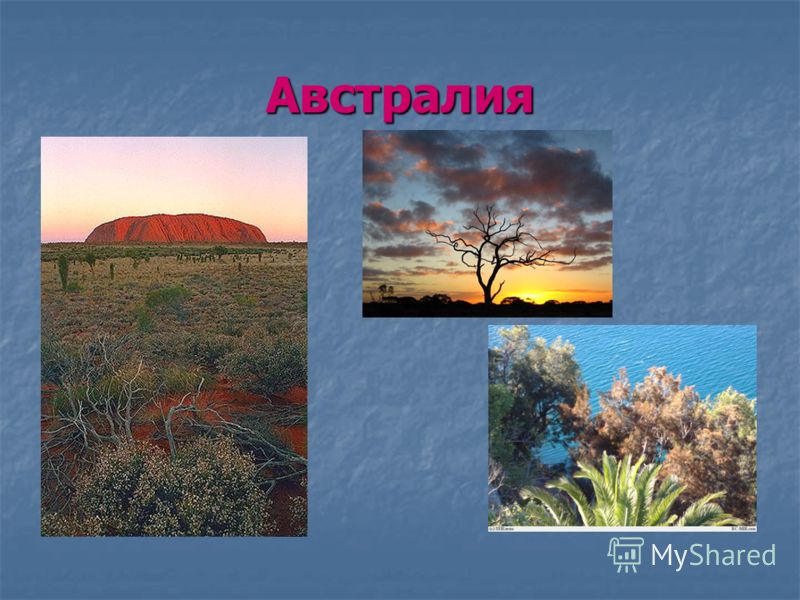
Australia in facts and figures. Among the other continents of Earth A, Australia occupies a special position. It is the smallest continent in terms of size. On the territory of Russia will be located twice. Among the other continents of Earth A, Australia occupies a special position. It is the smallest continent in terms of size. On the territory of Russia will be located twice. Australia is the driest continent on Earth, the most sparsely populated and the flattest. Australia is the driest continent on Earth, the most sparsely populated and the flattest. IN geographically And Australia has not been fully studied; areas of tropical deserts, in which there are no oases, have yet to be studied. In geographic terms, Australia has not been fully studied; areas of tropical deserts in which there are no oases have yet to be studied. 75% of Australia's living organisms are endemic. 75% of Australia's living organisms are endemic. There are no volcanoes on the mainland and earthquakes do not occur. There are no volcanoes on the mainland and earthquakes do not occur.

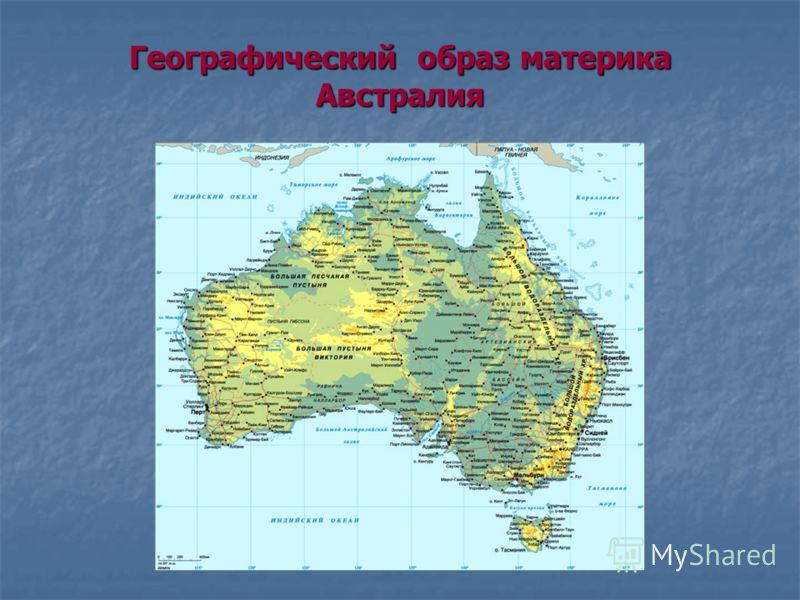
Let's put on contour map. Let's put it on a contour map. Coral Sea Coral Sea Tasman Sea Tasman Sea Great Australian Gulf Great Australian Gulf Gulf of Carpentaria Gulf of Carpentaria Indian Ocean Indian Ocean Pacific Ocean Pacific Ocean York Arnhem Land Peninsula Arnhem Land Peninsula Great Barrier Reef Great Barrier Reef
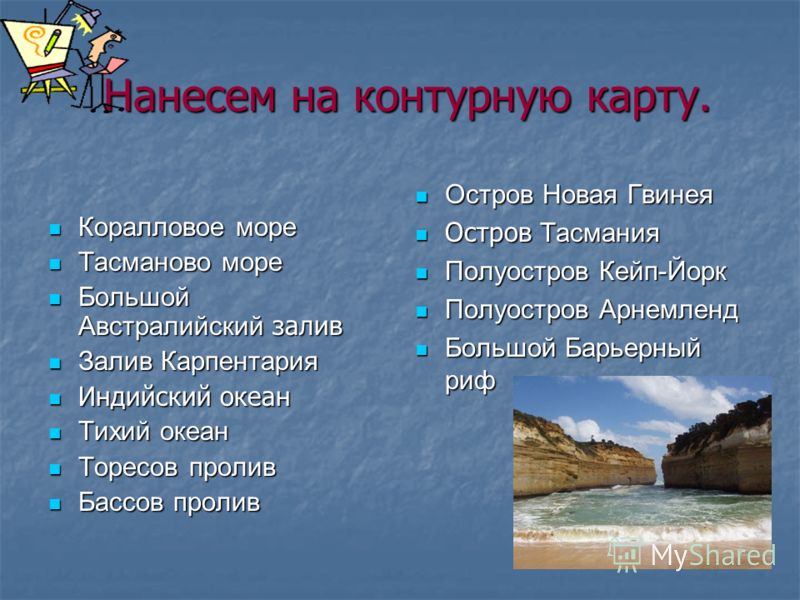
Plan of the characteristics of the mainland. Physical and geographical position of the mainland. Physical and geographical position of the mainland. Relief, tectonic structure, minerals. Relief, tectonic structure, minerals. Climate. Climate. Inland waters. Inland waters. Soils. Soils. natural areas. Flora and fauna. natural areas. Flora and fauna. Population. Economic activity. Population. Economic activity. States and capitals. States and capitals.

Geographic location Geographic location is an "address" geographical feature, by which it can be found on Earth. That is, we must determine the location of this object on the globe. A geographic location is the "address" of a geographic feature by which it can be found on Earth. That is, we must determine the location of this object on the globe. Determine how the mainland is located relative to the equator, the tropics and the prime meridian. Determine how the mainland is located relative to the equator, the tropics and the prime meridian. Find the coordinates of the extreme points of the mainland in degrees and the length of the mainland in kilometers from north to south and from east to west. Find the coordinates of the extreme points of the mainland in degrees and the length of the mainland in kilometers from north to south and from east to west. In what climatic zones is the mainland located? In what climate zones is the mainland located? Determine what seas and oceans wash the mainland? Determine what seas and oceans wash the mainland? How is the mainland relative to other continents? How is the mainland relative to other continents?
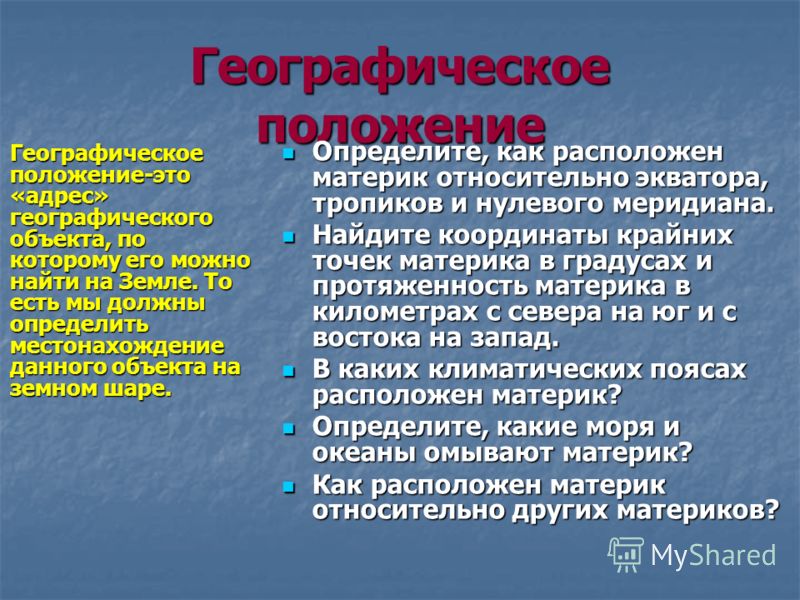
Plan of the physical and geographical position of the mainland. The position of the continent in relation to the equator. The position of the continent in relation to the equator. The position of the mainland in relation to the prime meridian. The position of the mainland in relation to the prime meridian. Extreme points, their coordinates. Extreme points, their coordinates. The length of the mainland from N to S and from W to E in degrees and kilometers. The length of the mainland from N to S and from W to E in degrees and kilometers. Mainland area. Mainland area. The position of the mainland in relation to the seas and oceans. The position of the mainland in relation to the seas and oceans. The position of the continent in relation to other continents. The position of the continent in relation to other continents. Conclusion: about the features of the physical and geographical position of the mainland Conclusion: about the features of the physical and geographical position of the mainland
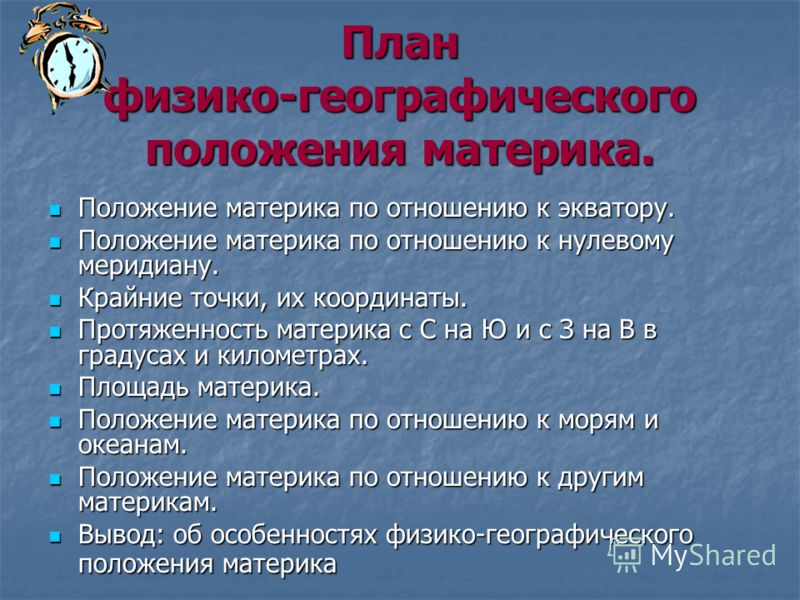
The position of the mainland in relation to the equator and the prime meridian The prime meridian does not cross Australia, the mainland lies entirely in the eastern hemisphere. The prime meridian does not cross Australia, the mainland lies entirely in the eastern hemisphere. The equator does not cross the mainland. Australia is located entirely in the southern hemisphere The equator does not cross the mainland. Australia is located entirely in the southern hemisphere

Extreme points, their coordinates m. York - 11 s. sh., 143 in. m. York - 11 s. sh., 143 in. m. South East Point - 3 9 s. sh. 146 c. m. South East Point - 3 9 s. sh. 146 c. m. Steep Point - 26 s. sh. 114 c. m. Steep Point - 26 s. sh. 114 c. d., m. Byron - 28 s. w east m. Byron - 28 s. w hd
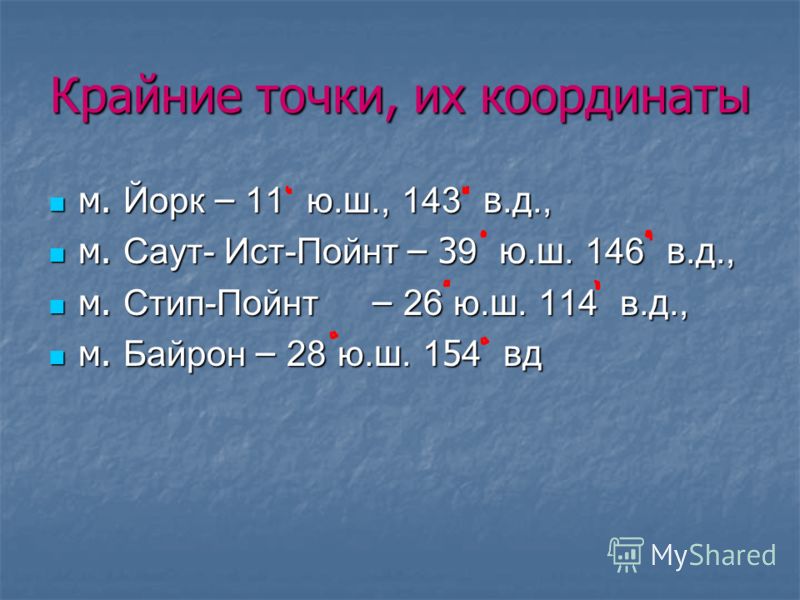
The length of the mainland from N to S and from W to E in degrees and kilometers N - S N - S = =28 111km 28 =3108km 111km 28 =3108km W - EW - E = = km 32 =3347km 104.6km 32 =3347km
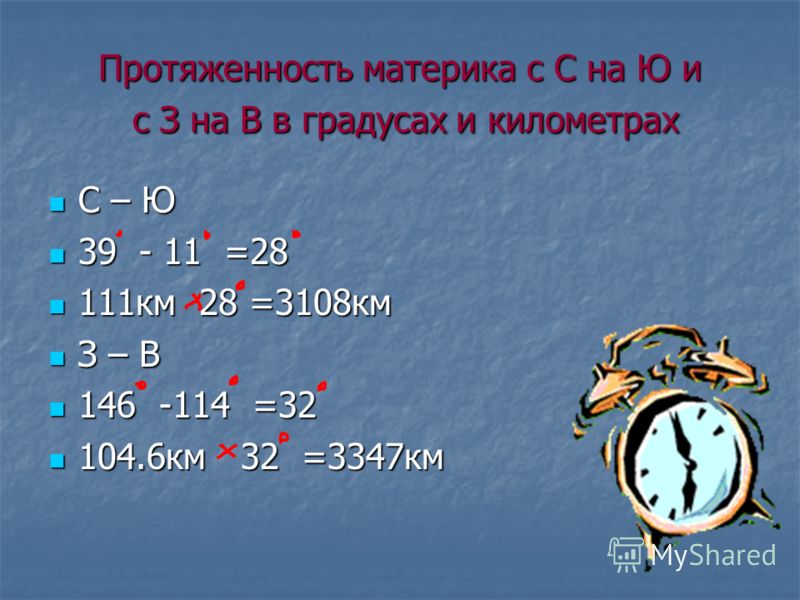
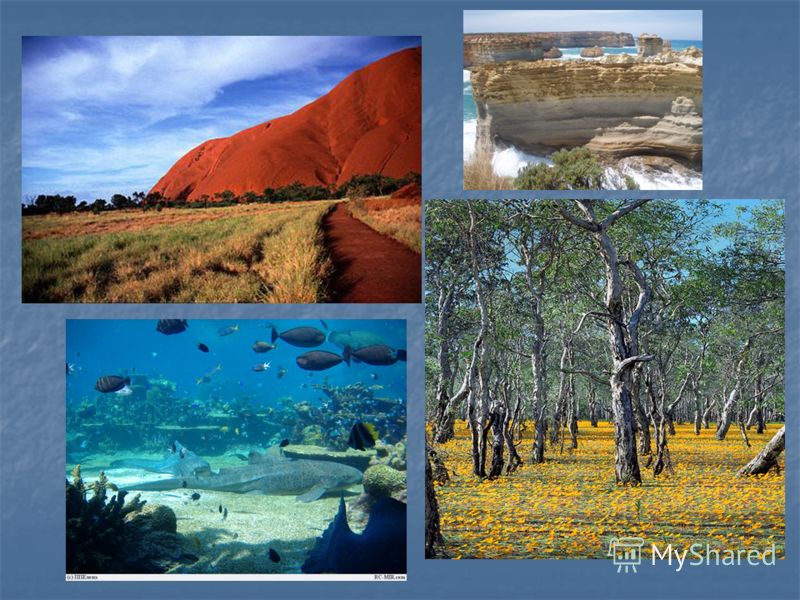
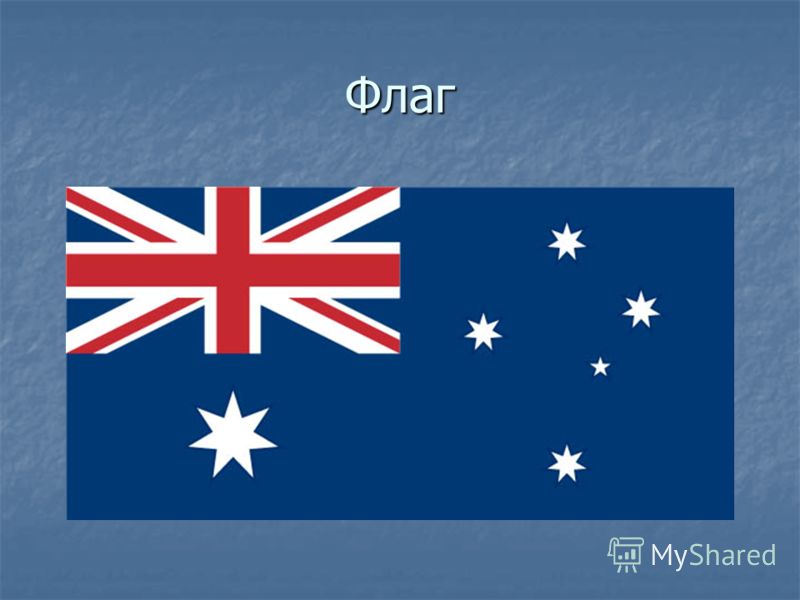
19
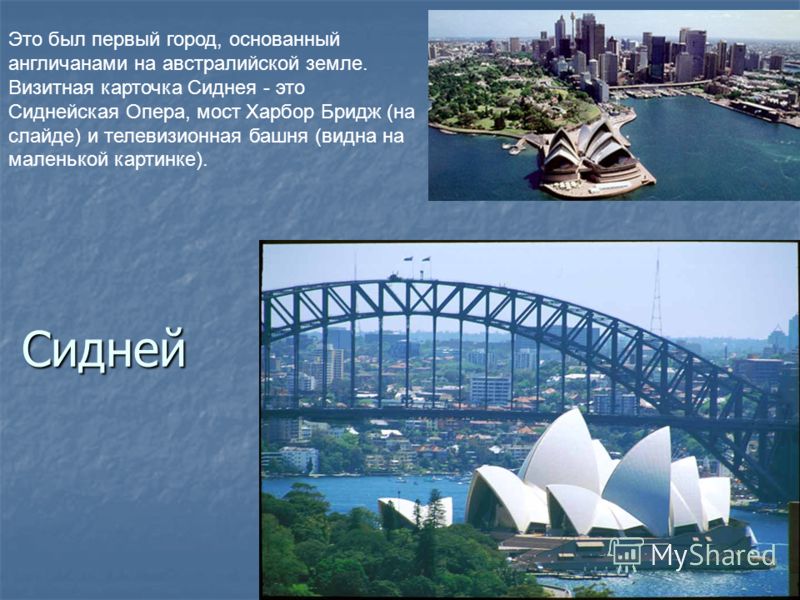

Someone wittily called Australia "the attic of the world", meaning a place where all sorts of junk is stored. And it was said not at all to offend the Australians. After all, first of all, we are talking about the fauna of the Fifth Continent, since such amazing and ancient creatures as kangaroos or platypus cannot be found anywhere else in the world. Note, however, that this "attic" is inhabited by more than 150 species of marsupial mammals, including marsupial mice, wolves and even bears. Although millions of years ago they were common everywhere and even in Europe. But later, the land bridge between Australia and Southeast Asia collapsed and went under water, leaving on the surface only a chain of islands, now called Indonesia. 23

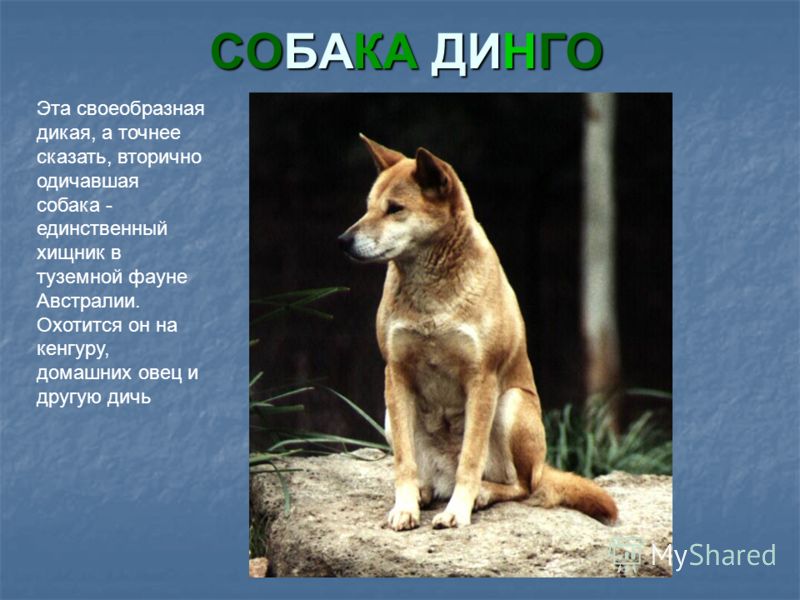
EMU The emu is the second largest bird in the world. They have a long neck and very long, thin legs. They can run very fast (up to 50 km/h) and can even swim. This is a very curious animal. They eat grass, insects, fruits and seeds. Emu lays dark green eggs (from 5 to 20 eggs), the nest is built from grass and weeds on the ground, reaches 1m wide. Emu ostriches run faster than a horse, and the kick of their foot is not weaker than the kick of a horse's hoof.



CONCLUSION Australia is located south of the equator. Australia is located south of the equator. Australia is located east of the prime meridian. Australia is located east of the prime meridian. Australia is located mostly in the tropical zone. Australia is located mostly in the tropical zone. The sixth continent by area. The sixth continent by area. It is washed by the Pacific and Indian oceans. It is washed by the Pacific and Indian oceans. Far from the mainland. Far from the mainland. It has a favorable physical and geographical position. It has a favorable physical and geographical position. Has a unique organic world. Has a unique organic world.

Summary So, you today: So, today you: 1) Independently learned the answers to all the questions; 2) We repeated the plan for the characteristics of the mainland, which made it possible to independently study and easily describe mainland Australia; 3) Strengthened the skills of describing the physical and geographical position of the mainland; 1) Independently learned the answers to all the questions posed; 2) We repeated the plan for the characteristics of the mainland, which made it possible to independently study and easily describe mainland Australia; 3) Strengthened the skills of describing the physical and geographical position of the mainland;
Australia is the smallest continent on Earth. Together with the adjacent islands, it is entirely located in the southern hemisphere. The name of this continent, discovered and settled later than others, comes from the Latin word australis - southern.
The southern tropic crosses Australia so that a smaller part of the mainland is located to the north of it. The extreme points of the mainland in the north are Cape York (10 ° 41 "S), in the south - Cape South East Point (39 ° 11" N), in the west - Cape Steep Point (113 ° 05 "E), in the east - Cape Byron (153 ° 34" E). The length of Australia from north to south is 3200 km, from west to east about 4100 km, the area is 7614.5 thousand km2.
The modern name of the mainland appeared on the maps relatively recently - in the early 20s. 19th century Prior to this, separate parts of the continent were called by the names received from the discoverers. So, the Dutch called the northern lands New Holland, the first English colony in the east began to be called New South Wales. And only when the captain of the Royal Navy Matthew Flinders sailed around the mainland, the name "Australia" appeared.
In the north off the coast of Australia are the islands of Melville, Bathurst, Groote Island and other smaller ones, in the south - located within the continental shelf of the island of Tasmania, King, Flinders and Kangaroo. In the west the most large island— Dirk Hartog, to the east — Fraser.
Australia is bordered by the Pacific and Indian oceans. It is not connected by land to any other continent. Therefore, Australia, also referring to its small size, is sometimes called the mainland-island.
The nature of Australia is unique to a greater extent than the nature of all other continents, except for Antarctica. It is distinguished by the antiquity of landscapes, originality, endemism and antiquity of the organic world, features of the development and change of natural conditions by man.
To the north and east of Australia, in the southwestern Pacific Ocean, there are many large and small islands of continental, coral and volcanic origin. The whole set of these islands is called Oceania. The total area of the islands of Oceania is approximately 1.3 million km2.
Oceania is usually divided into several parts.
The largest western islands, closest to Australia, excluding New Zealand called Melanesia. Melanesia includes New Guinea, Solomon islands, New Caledonia and etc.
New Zealand, located much to the south, is singled out especially.
Small islands north of Melanesia and west of 177° E (Marian, Caroline, Marshall, etc.) are called Micronesia.
All other islands in the central and southern parts of the Pacific Ocean east of 177 ° E belong to Polynesia. These are the islands of Hawaii, Line, Society, etc.
This division is historical and ethnographic; it does not coincide with the division of Oceania according to genetic and physical-geographical features.
Island arc from New Guinea to New Zealand, including the Fiji Islands to the east, separating the islands from the mainland water basins, is a continuation of the Pacific island arcs.
By climate formation and the formation of the organic world, these islands are closely connected with Australia, being in relation to it approximately in the same position as the East Asian islands in relation to Eurasia, although in this case the similarity of the nature of the islands with the nature of the mainland is expressed to a somewhat lesser extent. The islands of the open part of the Pacific Ocean are genetically related to the oceanic crust and have never experienced the influence of large areas of land during their existence. Their nature is distinguished by great originality and typically oceanic features.
From the north, Australia is washed by the Timor and Arafura epicontinental seas. In addition, in the north is one of the largest bays within the mainland - Carpentaria. A strip of shallow water stretches along the western and southern coasts mainland, which are washed by the waters of the Indian Ocean. In the east, the Coral and Tasman Seas adjoin Australia, which are deep basins with oceanic or transitional type crust and with great depths (over 5000 m). The Melanesian, New Caledonian, and other basins are no less deep, separating underwater uplifts and ridges with continental and coral islands located on them. From the outside, and partly from the side of the seas, trenches (Vityaz, Tonga, Karmadek, etc.) stretch along the island arcs with maximum depths of more than 9 and even 10 thousand meters.




